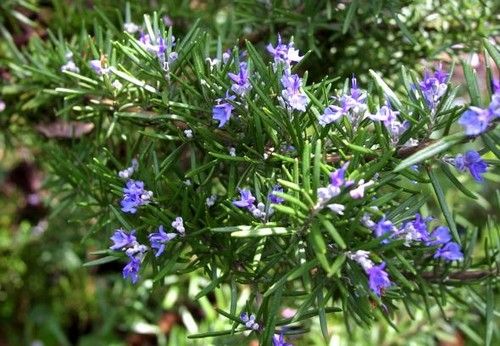
Parts Used: Leaves, stems and flowers
Constituents: essential oil (borneol, camphene, camphor, cineole, limonene, linalool); flavonoids, rosmarinic acid and other phenolic acids; diterpenes, triterpenes
Uses
Cough: Inhale steam of strong decoction of herb.
- Diuretic: Take decoction of herb as needed.
- Gas pains: Take decoction of herb as needed.
- Rheumatism: Make decoction of herb and soak affected area.
- Conjunctivitis: Infusion of leaves used as an eyewash, 4 to 5 times daily.
- Vapor baths, using 30 to 40 gms of leaves in boiling water for rheumatism, catarrh.
- Juice of leaves applied to areas of thinning hair and dandruff; also, as rosemary vinegar.
- Rosemary tea also used as conditioning hair rinse,
- Infusion of leaves as tea for dyspepsia, flatulence.
- Decoction of leaves as mouthwash for gums disease, halitosis, sore throat.
Aromatic bath: Use decoction of herb.
- Infusion with oil for massages.
- Daily use of rosemary tea believed to prevent cataracts.
- For Hair wash: Steep 25 g of rosemary in 2 pints of cider vinegar for two weeks, shaking occasionally; strain. In hair washing, put 1-2 tsp in the final rinse.
- For dandruff, massage rosemary vinegar thoroughly into scalp, 20 mins before washing.
- As hair restorer, romero is macerated in alcohol and rubbed on twice daily. The hair lotion is suppose to stimulate the hair bulbs to renewed activity and prevents baldness.
- Postpartum bath: Boil a head of petals in a quart of water). (Related article: Suob)
- Used as antispasmodic in renal colic and dysmenorrhea.
- Decoction of leaves used as carminative and as an abortive.
- Infusion of leaves used for gastralgia, dyspepsia, flatulence and palpitations.
- Leaves used as febrifuge.
- In Mexico, a 2% infusion of leaves or its essence (6 drops every 24 hours) is considered stomachic.
- Volatile oil used as stimulant in liniments.
do you know romero serva plants for kidney? do you have image?
ReplyDeletehttp://android-fixers.blogspot.com
do you know romero serva plants for kidney? give me image.
ReplyDeleteYou may also like this links...open this tips and tricks in all android gadget...Click here and find some helpful information for your android gadget or devices..latest android os...some tricks and step by step tutorials in all android